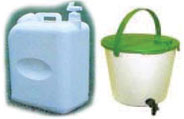Safe storage
Whatever type of treatment method is used, it is essential that water is stored safely and hygienically. Even if water has come from an improved source, this will not guarantee that it is safe because contamination can occur in the household due to poor storage and handling practices. The principal health risk associated with household water storage is the ease of recontamination, particularly where the members of a family or community do not all follow good hygiene practice. Safe storage is especially designed to eliminate sources of recontamination by keeping objects, including hands, out of the system.

What is it about the two containers shown above that make them safe for storing water?
They both have lids which prevent dust and insects from falling in the water and they both have taps so people can take water without removing the lid or dipping their hands or a smaller container, which may be dirty, into the water.
It is important to recognise that unsafe water is not made safe just by using safe storage methods. Safe storage helps to ensure that post-treatment recontamination does not occur within the household.